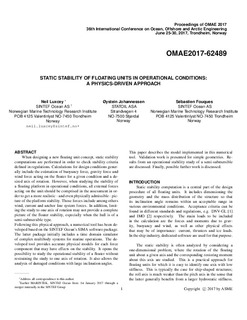| dc.contributor.author | Luxcey, Neil | |
| dc.contributor.author | Johannessen, Øystein | |
| dc.contributor.author | Fouques, Sébastien | |
| dc.date.accessioned | 2017-10-25T16:53:27Z | |
| dc.date.available | 2017-10-25T16:53:27Z | |
| dc.date.created | 2017-10-24T09:45:00Z | |
| dc.date.issued | 2017-06 | |
| dc.identifier.citation | ASME 2017 36th International Conference on Ocean, Offshore and Arctic Engineering; Volume 3A: Structures, Safety and Reliability | nb_NO |
| dc.identifier.isbn | 978-0-7918-5765-6 | |
| dc.identifier.uri | http://hdl.handle.net/11250/2462218 | |
| dc.description.abstract | When designing a new floating unit concept, static stability computations are performed in order to check stability criteria defined in regulations. Calculations for design conditions generally include the estimation of buoyancy force, gravity force and wind force acting on the floater for a given condition and a desired axis of rotation. However, when studying the stability of a floating platform in operational conditions, all external forces acting on the unit should be comprised in the assessment in order to get a more realistic — and even physically admissible — picture of the platform stability. Those forces include among others wind, current and anchor line system forces. In addition, limiting the study to one axis of rotation may not provide a complete picture of the floater stability, especially when the hull is of a semi-submersible type. Following this physical approach, a numerical tool has been developed based on the SINTEF Ocean’s SIMA software package. The latter package initially includes a time domain simulator of complex multibody systems for marine operations. The developed tool provides accurate physical models for each force component that may have effects on the stability. It opens the possibility to study the operational stability of a floater without restraining the study to one axis of rotation. It also allows the analysis of damaged conditions with large inclination angles. This paper describes the model implemented in this numerical tool. Validation work is presented for simple geometries. Results from an operational stability study of a semi-submersible are discussed. Finally, possible further work is discussed. | nb_NO |
| dc.language.iso | eng | nb_NO |
| dc.relation.ispartof | ASME 2017 36th International Conference on Ocean, Offshore and Arctic Engineering - Volume 3A: Structures, Safety and Reliability | |
| dc.relation.ispartofseries | ASME Proceedings | Structures, Safety and Reliability;OMAE2017-62489 | |
| dc.subject | Physics | nb_NO |
| dc.subject | Static stability | nb_NO |
| dc.title | Static Stability of Floating Units in Operational Conditions: a Physics-Driven Approach | nb_NO |
| dc.type | Chapter | nb_NO |
| dc.description.version | acceptedVersion | nb_NO |
| dc.rights.holder | Copyright © 2017 by ASME | nb_NO |
| dc.identifier.doi | 10.1115/OMAE2017-62489 | |
| dc.identifier.cristin | 1507095 | |
| cristin.unitcode | 7566,8,0,0 | |
| cristin.unitcode | 7566,9,0,0 | |
| cristin.unitname | Ocean Engineering | |
| cristin.unitname | Hydrodynamikk | |
| cristin.ispublished | true | |
| cristin.fulltext | postprint | |
| cristin.qualitycode | 1 | |
